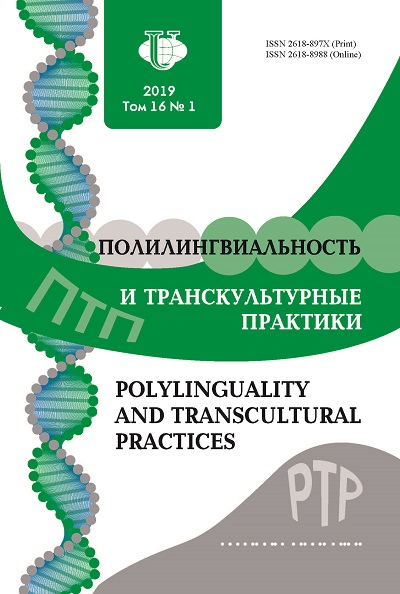Vol 16, No 1 (2019)
- Year: 2019
- Articles: 16
- URL: https://journals.rudn.ru/polylinguality/issue/view/1172
- DOI: https://doi.org/10.22363/2618-897X-2019-16-1
Full Issue
To our readers
TO OUR READERS
 7-8
7-8


 9-12
9-12


Languages in contact
Language Socialization in Bilingual Families: Functional Distribution of Languages in Baby-directed Talk
Abstract
 13-20
13-20


Language Biographies of the Respondents of Moscow Region Chuvash Diaspora
Abstract
The article presents the results of a sociolinguistic survey conducted by the author in the Chuvash diaspora of Moscow region. The actual use of the Chuvash language in the conditions of Diaspora residence is determined, among other things, by the previous language experience of respondents in their small homeland. The most common stages of language biography are: languages used by respondents in conversation with parents, older relatives, peers in childhood before school; the language used in teaching in primary school, in secondary school, in High school, - all these factors allow to reveal various ways of ethnic language acquisition.
 21-34
21-34


American Stage of Pitirim Sorokin’s Linguistic Biography
Abstract
The article discusses the features of the bilingualism of an eminent sociologist of the twentieth century Pitirim Sorokin in the American period of his life. The purpose of the study is to identify and explain the linguistic features of his scientific thinking in connection with the development of his scientific worldview. The study is based on the materials of Pitirim A. Sorokin Collection at the University of Saskatchewan (Canada). Archival manuscripts and research notes allow us to trace the process of changing the language and switching codes in the professional activities of Pitirim Sorokin after moving to the United States of America. It has been established that the use of a mixed metalanguage by Pitirim Sorokin can be considered as additional evidence of the continued connection with the Russian period of his life and scientific activity. Russian remained for him a tool of scientific thinking, planning and management.
 35-44
35-44


LITERARY SPACE
Translingualism / Transculturality and Ethno-Cultural Identity: Complementarity or Conflictness?
Abstract
 45-51
45-51


The Phenomenon of C.T. Aitmatov: To the 90th Birthday of the Writer
Abstract
The purpose of the article dedicated to the 90th anniversary of Chinghiz Aitmatov’s birth is the study of the phenomenon of the writer’s artistic world, the uniqueness of which is due to a special author’s vision, manifested in the mythopoetic and philosophical understanding of life, in the “new” type of literary thinking, in creating a holistic national image of the world, in the “linguistic cosmos” of the bilingual author. On the material of the texts “The White Sheamboat”, “The Day Lasts More Than a Hundred Years”, “Scaffold”, “When the Mountains Fall (Eternal Bride)” and others, the poetics of the title, spatial loci and images of animals, the function of motives, the semantics of the circle, the specific character of poetic language are analyzed. The thirst for creativity as the need for “artistic perception of life” is considered in the article in two main aspects, formulated by Aitmatov himself as the Artist’s responsibility before the future: “knowledge of infinite beauty and infinite contradiction of the world”. The results of the text analysis are correlated in the article with the creative principles of the author, which made it possible to define the phenomenon of the artistic world of the bilingual writer as an achieving a “new level of consciousness” (Chinghiz Aitmatov’s “Linguistic Cosmos”).
 52-62
52-62


Self-Identification of Ravil Bukharayev’s Lyrical Subject (as seen in A Wreath of Wild-Growing Sonnets)
Abstract
 63-72
63-72


Transculturation of the Hero in G. Belger’s Novel “The Home of the Wanderer”
Abstract
Using the methods of literary analysis, the author tries to trace the evolution of the hero of the novel by G. Belger in the aspect of the transcultural approach. The central object of the study was the “House” archetype. The author comes to the conclusion that the elements of different levels associated with this archetype - from ontological categories (“here-being”, “there-being”) to symbols allow explicating Belger’s idea of Allness, which serves as an alternative to Homelessness and Findability.
 73-83
73-83


Theory of Translation
Particle - a Small Lexical Unit or an Endless Scientific Project?
Abstract
 84-94
84-94


Bilingual education
Features of Teaching Russian as a Foreign Language in Bilingual Audience
Abstract
The article is devoted to the peculiarities of teaching Russian to bilingual students: overcoming the low motivation of deep language learning, difficulties in writing, socialization, intercultural communication, issues of the professional language learning. The authors note that the special program written for bilinguals includes expanding vocabulary, work on the texts, writing samples, audio and video materials. Professional language learning and extracurricular work play a significant role in the Russian language study.
 95-101
95-101


Potential of Polycode Texts for the Organization of Operational Interaction between Study Materials and User
Abstract
The article is devoted to the problem of optimizing the operational interaction between an educational materials and aids and the user. The author explains and justifies the need to create a polycode interface for interaction management, whose main features are simplicity, accessibility, versatility and ergonomics. It represents an original development of a multi-view interaction interface and its practical implementation.
 102-111
102-111


Round Table
To the 90th Anniversary of G.P. Melnikov. Round Table “System Typology of Languages: Analysis and Synthesis in the Science of Language”, November 9, 2018
Abstract
 112-124
112-124


Memento
Nadezhda Ivanovna Gainullina: In Memoriam
Abstract
 125-131
125-131


Release
“Within the Thinking Worlds”: Feedback on “Bi-, Poly-, Translingualism and Language Education”. 2018. Moscow: PFUR. 448 p
Abstract
 132-135
132-135


Regional Methodical Seminar “Winter Readings - 2019”
 136-138
136-138















